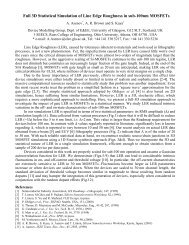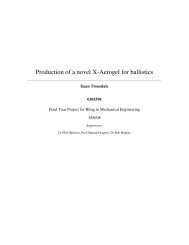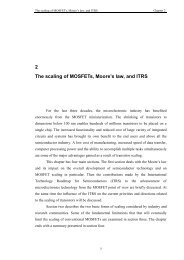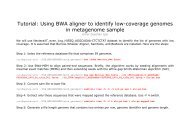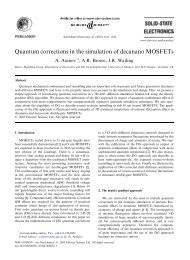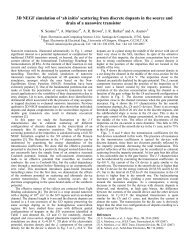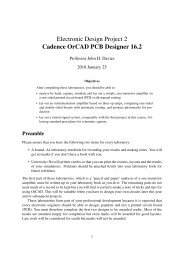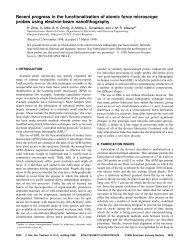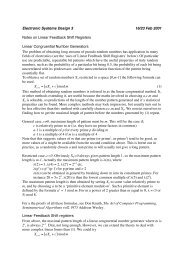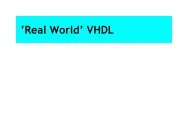Plastic model with non-local damage applied to concrete
Plastic model with non-local damage applied to concrete
Plastic model with non-local damage applied to concrete
You also want an ePaper? Increase the reach of your titles
YUMPU automatically turns print PDFs into web optimized ePapers that Google loves.
PLASTIC MODEL WITH NON-LOCAL DAMAGE 75hardening modulus:H p ¼@f p dh@s y dk pð11ÞMore specifically, the actual value of H is compared <strong>to</strong> two critical values, H crit and H crit;p ;which are obtained by classical <strong>local</strong>ization analysis of the corresponding <strong>local</strong> <strong>model</strong> based onthe acoustic tensor [32,33]. The value H crit is evaluated for the complete <strong>damage</strong>-plastic <strong>model</strong>,while H crit;p is evaluated for the plastic part only (<strong>with</strong> artificially ‘frozen’ <strong>damage</strong>). Thedifference between H crit and H crit;p ; denoted as DH crit;d ; is usually larger than zero. Anotherimportant characteristic value H dis is defined asH dis ¼ H crit;p þð1 mÞDH crit;d ð12ÞSuppose that the body deforms uniformly up <strong>to</strong> the current state, and the boundaryconditions admit a uniform solution of the rate problem. The question is whether this solution isunique, or whether there exists another solution <strong>with</strong> plastic yielding <strong>local</strong>ized in<strong>to</strong> a band.According <strong>to</strong> Jira´sek and Grassl [27], the following cases can be distinguished:* H crit 5H p }no <strong>local</strong>ization possible;* H dis 5H p 4H crit }<strong>local</strong>ization <strong>with</strong> continuous strain rate;* H p 5H dis }<strong>local</strong>ization <strong>with</strong> discontinuous strain rate.The special case H p ¼ H dis requires a more refined discussion.In the finite element method, a discontinuous strain rate usually corresponds <strong>to</strong> a fully<strong>local</strong>ized zone of plastic strains, which is related <strong>to</strong> the size of the finite element mesh. Incontrast <strong>to</strong> that, <strong>local</strong>ization <strong>with</strong> a continuous strain rate leads <strong>to</strong> a mesh-independent zone ofinelastic strains. In the following sections, specific versions of the <strong>non</strong>-<strong>local</strong> <strong>damage</strong>-plastic<strong>model</strong> for cohesive-frictional materials are <strong>applied</strong> <strong>to</strong> structural problems <strong>with</strong> different failuremodes. In particular, the influence of parameters m and H crit;p is studied.4. ONE-DIMENSIONAL PLASTICITY COMBINED WITH NON-LOCAL DAMAGEThe first structural example is a bar subjected <strong>to</strong> uniaxial tension (Figure 1). In this simple case,we set ’k p ¼j’e p j: The plastic part of the <strong>model</strong> exhibits hardening until the cumulative plasticstrain k p attains a certain level k 0 ; after which the behaviour becomes perfectly plastic(i.e. H p ¼ 0). The hardening law (4) has the <strong>non</strong>-linear form(s y ¼ hðk p Þ¼ s i þðs 0 s i Þðk 2 p 3k p k 0 þ 3k 2 0 Þk p=k 3 0if k p 4k 0ð13Þs 0 if k p > k 0where s i is initial yield stress, s 0 is the ultimate (maximum) yield stress, k p is the cumulativeplastic strain, and k 0 is the plastic strain at peak. The <strong>damage</strong> evolution starts when themaximum yield stress is mobilized (which happens at k p ¼ k 0 ) and is driven by the variableCopyright # 2005 John Wiley & Sons, Ltd. Int. J. Numer. Anal. Meth. Geomech. 2006; 30:71–90



